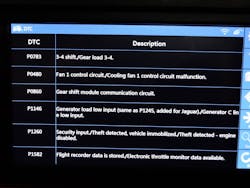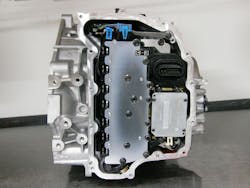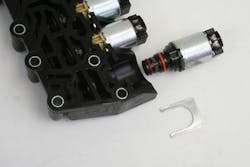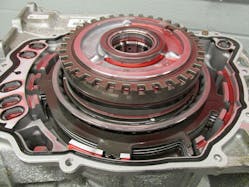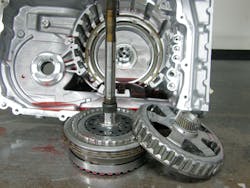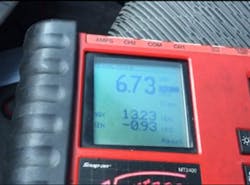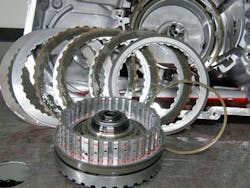Diagnostic Trouble Codes are no doubt quite helpful when diagnosing a malfunctioning vehicle. Sometimes, when the scan tool reports a never ending list of trouble codes like the ones seen from a 2005 Jaguar S-Type (X200) V6-3.0L in Figures 1 through 4, it might be a bit overwhelming to know where to start. In scenarios like this, my first approach is to know the history of the vehicle, if possible.
FIGURES 1-4
I do a cursory view of the electrical system, looking for fatigued wiring harnesses, pinched wires or wires melted on the exhaust or manifold. I inspect connectors looking for water intrusion and then conduct power and grounds tests. I repair any system voltage concerns before proceeding any further. Hopefully by this time I’ve knocked out a few problems, but if not, the sleeves roll up and step by step diagnostics are performed based on which codes I believe might be causing other codes to set.
Through the years, it is interesting to see how the types of codes have developed with the advancement of technology and the variety of transmission types we now areseeing. One such example is gear ratio codes being replaced with solenoid performance codes. As the title of the article goes, gear ratio errors are “slipping” away.
For years, we would see a generic ratio code P0730 for any gear error ratio fault and/or a P0731 for a first gear fault, P0732 for second, P0733 for third, P0734 for fourth and P0735 for fifth. P0736 was for reverse and P0737 would be a generic TCM Engine Speed Output Circuit
fault. Now, when you look up a code list for a six speed transmission, the generic P0730 series codes are no longer there. You might see a code list where it jumps from P0723 to P0741, no P0730 series codes listed at all.
Let’s consider GM’s front wheel drive 6-speed transmissions. Torque rating wise, they come as small as a 6T30 (1.2L) to as high as a 6T75 (3.9L). You will not find gear ratio error codes as much as you will find solenoid performance codes instead. Take for example a 6T30/40/45/50 series transmission (GF6). These transmissions have the computer mounted on the valve body inside the transmission (Figure 5). Thecombination of the TCM, solenoids and valve body together as an assembly has been called a Mechatronic unit with many European vehicles. GM uses what Delphi calls the Transmission Electro-Hydraulic Control Module or TEHCM (Q8) for short (Figure 6). This TCM/Solenoid body TEHCM assembly is mounted onto the valve body.
There are seven solenoids mounted into the TEHCM housing used to control shift feel and shift scheduling for six forward gears, converter clutch apply and one reverse gear. There is a line pressure control solenoid (Line PCS), a TCC PCS, PCS’s 2, 3, 4 and 5 and one On/Off shift solenoid.
Typically, when a TCM/PCM would command a specific gear, it would observe the input and output speed of the transmission with which it could calculate the current gear ratio. Once calculated it should match the commanded gear and if it did not, a gear ratio error code would set for that specific gear.
General Motors has excellent data available regarding shift time along with the necessary pressure adjustments to maintain proper shift time as well monitoring gear ratio while in gear and the pressures to keep it there. These are all represented in shift time, TAP cells and steady state TAP cells (TAP – Transmission Adaptive Pressure). These PID’s are all great stuff for diagnosing shift concerns and gear ratio errors.
The tech’s job from a diagnostic standpoint would then be to consider all that is involved in obtaining the specific gear that is at fault beginning with the solenoid or solenoids that are in play. From there you would work your way into the related valves and small parts in the valve body to the actual components themselves. Things like servos and bands, friction and steel plates, clutch drums and clutch pistons, seals and rings, bushings and accumulators. The list goes on.
FIGURES 5-8
Now, rather than having a gear ratio code, a performance code or codes are set for the specific solenoid or solenoids responsible in making the shift change and holding the gear. One of the main reasons for this change is that solenoids are primarily doing most of the work controlling both the shift and clutch pressure. There are fewer valves in the valve body as a result of this. However, the tech still needs to consider all that is in play when there is a performance code set for a shift/pressure control solenoid.
This brings us back to the seven solenoids used in the 6T30/40/45/50 series transmission. The codes for these solenoids offer both hydraulic and mechanical performance codes and as well as electrical malfunctions with the exception of the Line Pressure Control Solenoid. This solenoid only has electrical malfunction codes assigned to it at this time. The codes and their basic definitions are as follows:
Shift Solenoid Valve 1 On/Off Normally Closed Solenoid
P0751 - Shift Solenoid Valve 1 Stuck Off
P0752 - Shift Solenoid Valve 1 Stuck On
P0973 - Shift Solenoid Valve 1 Circuit Low Voltage
P0974 - Shift Solenoid Valve 1 Circuit High Voltage
Pressure Control Solenoid Valve 2 Normally High Solenoid
P0776 - PCSV2 Stuck Off (Hydraulic/Mechanical Performance Malfunction)
P0777 - PCSV2 Stuck On (Hydraulic/Mechanical Performance Malfunction)
P0965 - PCSV2 Performance (Internal Electrical Performance Malfunction)
P0966 - PCSV2 Circuit Low Voltage
P0967 - PCSV2 Circuit High Voltage
Pressure Control Solenoid Valve 3 Normally High Solenoid
P0796 - PCSV3 Stuck Off (Hydraulic/Mechanical Performance Malfunction)
P0797 - PCSV3 Stuck On (Hydraulic/Mechanical Performance Malfunction)
P0969 - PCSV3 Performance (Internal Electrical Performance Malfunction)
P0970 - PCSV3 Circuit Low Voltage
P0971 - PCSV3 Circuit High Voltage
Pressure Control Solenoid Valve 4 Normally Low Solenoid
P2714 - PCSV4 Stuck Off (Hydraulic/Mechanical Performance Malfunction)
P2715 - PCSV4 Stuck On (Hydraulic/Mechanical Performance Malfunction)
P2719 - PCSV4 Performance (Internal Electrical Performance Malfunction)
P2720 - PCSV4 Circuit Low Voltage
P2721 - PCSV4 Circuit High Voltage
Pressure Control Solenoid Valve 5 Normally Low Solenoid
P2723 - PCSV5 Stuck Off (Hydraulic/Mechanical Performance Malfunction)
P2724 - PCSV5 Stuck On (Hydraulic/Mechanical Performance Malfunction)
P2728 - PCSV5 Performance (Internal Electrical Performance Malfunction)
P2729 - PCSV5 Circuit Low Voltage
P2730 - PCSV5 Circuit High Voltage
Torque Converter Clutch Pressure Control Solenoid Valve Normally Low Solenoid
P0741 - TCC PCSV Stuck Off (Hydraulic/Mechanical Performance Malfunction)
P0742 - TCC PCSV Stuck On (Hydraulic/Mechanical Performance Malfunction)
P2762 - TCC PCSV Performance (Internal Electrical Performance Malfunction)
P2763 - TCC PCSV Circuit Low Voltage
P2764 - TCC PCSV Circuit High Voltage
Line Pressure Control Solenoid Valve Normally High Solenoid
P0961 - PCSV Performance (Internal Electrical Performance Malfunction)
P0962 - PCSV Circuit Low Voltage
P0963 - PCSV Circuit High Voltage
You will notice in Figure 6 that there are four pressure control solenoids used to operate a specific clutch assembly. This is done through each of these solenoids having its own respective regulating valve. In other words, PCSV2 operates the 3-5-R clutch through a 3-5-R regulating valve to achieve 3rd, 5th and Reverse gears. PCSV 3 works the same way through its own regulating valve to achieve 4th, 5th and 6th gears. PCSV4 is responsible for 2nd and 6th gears while PCSV5 controls the 1-2-3-4 clutch in gears 1st through 4th, both through their own respective regulating valves (Figure 7).
FIGURES 9-12
When a hydraulic/mechanical fault occurs with one of these solenoids (as mentioned earlier), the diagnostic process begins with checking the operation of the solenoid and its related valve(s).
Unlike the 6T70/75 version, the solenoids in the 6T30/40/45/50 TEHCM can be easily removed from the assembly for inspection, which would include the rubber sealing rings as well (Figure 8). Sources are becoming available to replace these solenoids separately should there be a failure without having to replace the entire TEHCM assembly. Hopefully that will work out well.
If the solenoid inspects well and its related regulating valve is functional, something is wrong inside the transmission.
General Motors provides detailed information for each of these codes. Circuit/System description, conditions for running the DTC, conditions for setting the DTC, actions taken when the DTC is set to name a few. It also provides Circuit/System Testing so the technician can quickly begin to separate whether his hydraulic/mechanical performance code is a minor or major repair.
Using PCSV2 as an example, if code(s) P0776 and/or P0777 has set and it has been determined that the solenoid is not the cause, it offers up the following suggestions:
1. Actuator feed limit valve compromising circuit supply fluid to the solenoids.
2. 3-5-R Regulator Valve sticking or stuck.
3. A check ball in the valve body not seating correctly
These would be considered a minor repair in that the transmission would not have to be removed to make the repair. But if these all check out, with the 6T40 series style transmission, it’s time to pull the unit and inspect the 3-5-R clutch assembly. If it were the 6T70 series type transmission, there is a rear cover that can be pulled to give these clutches a look (Figure 9). Not so with the 6T40 unit. It all needs to come apart as the 3-5-R clutch drum assembly is located at the rear of the case (Figure 10). The sealing rings on the ring tower in the bottom of the case would need to be looked at. The drum area where the rings seal would need to be inspected for grooving (Figure 11). And then of course the clutch assembly itself including the apply piston (Figure 12).
As you can see, moving away from gear ratio codes to solenoid performance codes has actually simplified the diagnostic process. This example was with a compact little 6-speed transmission using five clutch pack assemblies. Compact transmission designs with minimal clutch pack assemblies also assists in simplifying diagnostics. With 9-speed transmissions already on the road today, the ones that have most of their solenoids doing the majority of the grunt work along with fewer valves in the valve body is a welcomed design diagnostically.
What is actually becoming complicated and very difficult to deal with is programming. It is mind boggling to think of all that is involved in writing a program to make just one shift under various loads, speed and temperature in conjunction with ABS, engine torque management, fuel economy and emissions. Now times that by nine shifts, which includes skip shift technology, sport and economy modes, and we can see how easily programming can become a problem. So the less we need to contend with when it comes to the transmission itself, the better. Part of the diagnostic process when it comes to programming, it is always a good idea to check for any factory TSBs for any re-flash updates related to your specific or related fault code.

